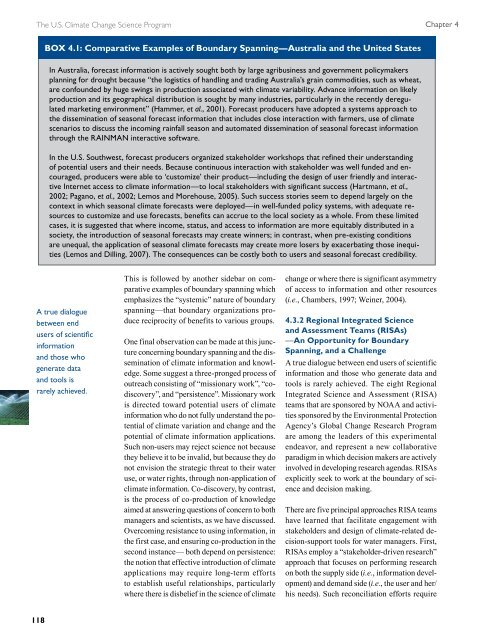Decision support experiments and evaluations using seasonal to ...
Decision support experiments and evaluations using seasonal to ...
Decision support experiments and evaluations using seasonal to ...
Create successful ePaper yourself
Turn your PDF publications into a flip-book with our unique Google optimized e-Paper software.
The U.S. Climate Change Science Program<br />
118<br />
BOX 4.1: Comparative Examples of Boundary Spanning—Australia <strong>and</strong> the United States<br />
In Australia, forecast information is actively sought both by large agribusiness <strong>and</strong> government policymakers<br />
planning for drought because “the logistics of h<strong>and</strong>ling <strong>and</strong> trading Australia’s grain commodities, such as wheat,<br />
are confounded by huge swings in production associated with climate variability. Advance information on likely<br />
production <strong>and</strong> its geographical distribution is sought by many industries, particularly in the recently deregulated<br />
marketing environment” (Hammer, et al., 2001). Forecast producers have adopted a systems approach <strong>to</strong><br />
the dissemination of <strong>seasonal</strong> forecast information that includes close interaction with farmers, use of climate<br />
scenarios <strong>to</strong> discuss the incoming rainfall season <strong>and</strong> au<strong>to</strong>mated dissemination of <strong>seasonal</strong> forecast information<br />
through the RAINMAN interactive software.<br />
In the U.S. Southwest, forecast producers organized stakeholder workshops that refined their underst<strong>and</strong>ing<br />
of potential users <strong>and</strong> their needs. Because continuous interaction with stakeholder was well funded <strong>and</strong> encouraged,<br />
producers were able <strong>to</strong> ‘cus<strong>to</strong>mize’ their product—including the design of user friendly <strong>and</strong> interactive<br />
Internet access <strong>to</strong> climate information—<strong>to</strong> local stakeholders with significant success (Hartmann, et al.,<br />
2002; Pagano, et al., 2002; Lemos <strong>and</strong> Morehouse, 2005). Such success s<strong>to</strong>ries seem <strong>to</strong> depend largely on the<br />
context in which <strong>seasonal</strong> climate forecasts were deployed—in well-funded policy systems, with adequate resources<br />
<strong>to</strong> cus<strong>to</strong>mize <strong>and</strong> use forecasts, benefits can accrue <strong>to</strong> the local society as a whole. From these limited<br />
cases, it is suggested that where income, status, <strong>and</strong> access <strong>to</strong> information are more equitably distributed in a<br />
society, the introduction of <strong>seasonal</strong> forecasts may create winners; in contrast, when pre-existing conditions<br />
are unequal, the application of <strong>seasonal</strong> climate forecasts may create more losers by exacerbating those inequities<br />
(Lemos <strong>and</strong> Dilling, 2007). The consequences can be costly both <strong>to</strong> users <strong>and</strong> <strong>seasonal</strong> forecast credibility.<br />
A true dialogue<br />
between end<br />
users of scientific<br />
information<br />
<strong>and</strong> those who<br />
generate data<br />
<strong>and</strong> <strong>to</strong>ols is<br />
rarely achieved.<br />
This is followed by another sidebar on comparative<br />
examples of boundary spanning which<br />
emphasizes the “systemic” nature of boundary<br />
spanning—that boundary organizations produce<br />
reciprocity of benefits <strong>to</strong> various groups.<br />
One final observation can be made at this juncture<br />
concerning boundary spanning <strong>and</strong> the dissemination<br />
of climate information <strong>and</strong> knowledge.<br />
Some suggest a three-pronged process of<br />
outreach consisting of “missionary work”, “codiscovery”,<br />
<strong>and</strong> “persistence”. Missionary work<br />
is directed <strong>to</strong>ward potential users of climate<br />
information who do not fully underst<strong>and</strong> the potential<br />
of climate variation <strong>and</strong> change <strong>and</strong> the<br />
potential of climate information applications.<br />
Such non-users may reject science not because<br />
they believe it <strong>to</strong> be invalid, but because they do<br />
not envision the strategic threat <strong>to</strong> their water<br />
use, or water rights, through non-application of<br />
climate information. Co-discovery, by contrast,<br />
is the process of co-production of knowledge<br />
aimed at answering questions of concern <strong>to</strong> both<br />
managers <strong>and</strong> scientists, as we have discussed.<br />
Overcoming resistance <strong>to</strong> <strong>using</strong> information, in<br />
the first case, <strong>and</strong> ensuring co-production in the<br />
second instance— both depend on persistence:<br />
the notion that effective introduction of climate<br />
applications may require long-term efforts<br />
<strong>to</strong> establish useful relationships, particularly<br />
where there is disbelief in the science of climate<br />
change or where there is significant asymmetry<br />
of access <strong>to</strong> information <strong>and</strong> other resources<br />
(i.e., Chambers, 1997; Weiner, 2004).<br />
4.3.2 Regional Integrated Science<br />
<strong>and</strong> Assessment Teams (RISAs)<br />
—An Opportunity for Boundary<br />
Spanning, <strong>and</strong> a Challenge<br />
A true dialogue between end users of scientific<br />
information <strong>and</strong> those who generate data <strong>and</strong><br />
<strong>to</strong>ols is rarely achieved. The eight Regional<br />
Integrated Science <strong>and</strong> Assessment (RISA)<br />
teams that are sponsored by NOAA <strong>and</strong> activities<br />
sponsored by the Environmental Protection<br />
Agency’s Global Change Research Program<br />
are among the leaders of this experimental<br />
endeavor, <strong>and</strong> represent a new collaborative<br />
paradigm in which decision makers are actively<br />
involved in developing research agendas. RISAs<br />
explicitly seek <strong>to</strong> work at the boundary of science<br />
<strong>and</strong> decision making.<br />
There are five principal approaches RISA teams<br />
have learned that facilitate engagement with<br />
stakeholders <strong>and</strong> design of climate-related decision-<strong>support</strong><br />
<strong>to</strong>ols for water managers. First,<br />
RISAs employ a “stakeholder-driven research”<br />
approach that focuses on performing research<br />
on both the supply side (i.e., information development)<br />
<strong>and</strong> dem<strong>and</strong> side (i.e., the user <strong>and</strong> her/<br />
his needs). Such reconciliation efforts require<br />
Chapter 4




